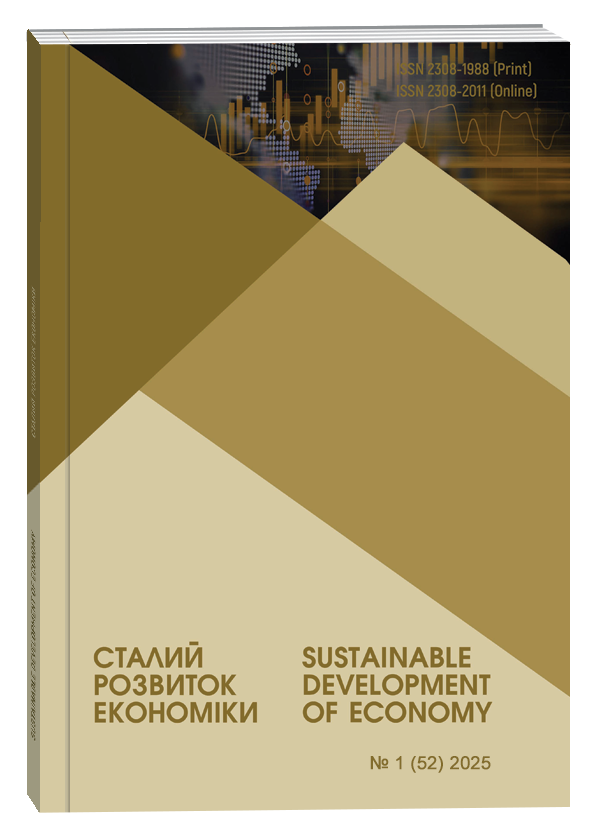ANALYSIS OF STRATEGIC ALTERNATIVES IN GLOBAL LOGISTICS NETWORKS AND APPROACHES TO COMPANY INTEGRATION
Abstract
The formation of cooperation strategies within international logistics alliances is an important step for enhancing the competitiveness of companies and optimizing logistics processes. This is a multifaceted process that involves careful planning, analysis of external and internal factors, as well as selecting promising development directions. Key stages include defining clear goals, assessing opportunities for integration and resource exchange, and creating a detailed action plan with clear distribution of responsibilities. Cooperation strategies enable companies to access shared resources and infrastructure, reducing logistics costs, improving customer service, and promoting innovation. Strategic cooperation within international logistics alliances is essential for enhancing competitiveness and ensuring the sustainable development of companies in the context of globalization. The main stages of forming a cooperation strategy are described, namely: defining goals and objectives, analyzing the external and internal environments, selecting strategic alternatives, developing a detailed action plan, and evaluating the results of cooperation implementation. A comparative analysis of four options for strategic alternatives of an international logistics alliance is performed, indicating their advantages and disadvantages, as well as their specific approach to alliance development. The article analyzes the stages of forming a global cooperation strategy and management tools that make it possible to choose the right strategy with greater accuracy. The choice of strategic alternatives is determined based on detailed analysis, which allows assessing opportunities for creating common platforms, integrating technologies, and sharing resources. It is also noted that even if strategic cooperation, especially international cooperation, is a complex process, this process is necessary to increase the company's competitiveness and optimize logistics costs. Successful implementation of the strategy requires taking into account a huge quantity of factors, opportunities and risks, as well as a high level of coordination among participants.
References
Madzík P., Falát L., Copuš L. Resilience in supply chain risk management in disruptive world: rerouting research directions during and after pandemic. Ann Oper Res. 2024. DOI: https://doi.org/10.1007/s10479-024-06126-x
Bui T.D., Tsai F.M., Tseng M.L., Tan R.R., Yu K.D.S., Lim M.K. Sustainable supply chain management towards disruption and organizational ambidexterity: A data driven analysis. Sustain Prod Consum. 2021. No. 26. P. 373-410. DOI: https://doi.org/10.1016/j.spc.2020.09.017
Qader G., Junaid M., Abbas Q., Mubarik M.S. Industry 4.0 enables supply chain resilience and supply chain performance. Technological Forecasting and Social Change. 2022. No. 185.
Zhao Y., Zhang X., Jiang W., Feng T. Does second-order social capital matter to green innovation? The moderating role of governance ambidexterity. Sustain. Prod. Consump. 2021. 25:271–284.
Settembre-Blundo D., González-Sánchez R., Medina-Salgado S., & García-Muiña F.E. Flexibility and resilience in corporate decision making: A new sustainability-based risk management system in uncertain times. Global Journal of Flexible Systems Management. 2021. No. 22(S2). P. 107–132.
Ліпич Л. Глобальні та локальні логістичні стратегії у міжнародних ланцюгах постачання. Економічний форум. 2022. No. 1. P. 158-166.
Shen S., Chang R.H., Kim K., Julian M. Challenges to maintaining disaster relief supply chains in island communities: Disaster preparedness and response in Honolulu, Hawai’i. Natural Hazards. 2022. No. 114. P. 1829–1855.
Харсун Л., Патковський С. Холодові ланцюги постачання продовольства: детермінанти управління і розвитку. Вісн. Київ. нац. торг.-екон. ун-ту. 2020. № 2. С. 48-57.
Tsolakis N., Niedenzu D., Simonetto M., Dora M., Kumar M. Supply network design to address United Nations Sustainable Development Goals: A case study of blockchain implementation in Thai fish industry. J. Bus. Res. 2021. No. 2 (131). P. 495–519.
Негода А., Русак Д. Міжнародна логістика та глобальні ланцюги постачань: навчальний посібник у схемах. Київ, 2023. 268 с.
Madzík P., Falát L., Copuš L. (2024) Resilience in supply chain risk management in a disruptive world: rerouting research directions during and after the pandemic. Ann Oper Res. DOI: https://doi.org/10.1007/s10479-024-06126-x
Bui T. D., Tsai F. M., Tseng M. L., Tan R. R., Yu K. D. S., Lim M. K. (2021) Sustainable supply chain management towards disruption and organizational ambidexterity: A data driven analysis. Sustain Prod Consum. no. 26, pp. 373-410. DOI: https://doi.org/10.1016/j.spc.2020.09.017
Qader G., Junaid M., Abbas Q., Mubarik M. S. (2022) Industry 4.0 enables supply chain resilience and supply chain performance. Technological Forecasting and Social Change, no. 185.
Zhao Y., Zhang X., Jiang W., Feng T. (2021) Does second-order social capital matter to green innovation? The moderating role of governance ambidexterity. Sustain. Prod. Consump, no. 25, pp. 271–284.
Settembre-Blundo D., González-Sánchez R., Medina-Salgado S., García-Muiña F. E. (2021) Flexibility and resilience in corporate decision making: A new sustainability-based risk management system in uncertain times. Global Journal of Flexible Systems Management, no. 22(S2), pp. 107–132.
Lipych L. (2022). Hlobalʹni ta lokalʹni lohistychni stratehiyi u mizhnarodnykh lantsyuhakh postachannya [Global and local logistics strategies in international supply chains]. Economic Forum. no. 1. pp. 158-166. (in Ukrainian)
Shen S., Chang R. H., Kim K., Julian M. (2022) Challenges to maintaining disaster relief supply chains in island communities: Disaster preparedness and response in Honolulu, Hawai'i. Natural Hazards, no. 114, pp. 1829–1855. (in Ukrainian)
Kharsun L., Patkovsky S. (2020) Kholodovi lantsyuhy postachannya prodovolʹstva: determinanty upravlinnya i rozvytku [Food cold chains: determinants of management and development]. Visn. Kyiv. nat. torg.-ekon. un-ty. no. 2. pp. 48-57. (in Ukrainian)
Tsolakis N., Niedenzu D., Simonetto M., Dora M., Kumar M. (2021) Supply network design to address United Nations Sustainable Development Goals: A case study of blockchain implementation in Thai fish industry. J. Bus. Res. no. 2 (131), pp. 495–519.
Negoda A., Rusak D. (2023). Mizhnarodna lohistyka ta hlobalʹni lantsyuhy postachanʹ: navchalʹnyy posibnyk u skhemakh [International Logistics and Global Supply Chains: A Course manual in diagrams]. Kyiv. 268 p. (in Ukrainian)


